Book Back Important Questions Answers | Choose the Correct Answers | Short, brief Answers | Zoology - Principles of Inheritance and Variation: Questions and Answers (Evaluation) | 12th Zoology : Chapter 4 : Principles of Inheritance and Variation
Chapter: 12th Zoology : Chapter 4 : Principles of Inheritance and Variation
Principles of Inheritance and Variation: Questions and Answers (Evaluation)
Evaluation
1. Haemophilia is more common in males because it is a
a) Recessive character carried by Y-chromosome
b) Dominant character carried by Y-chromosome
c) Dominant trait carried by X-chromosome
d) Recessive trait carried by X-chromosome
Answer: d) Recessive
trait carried by X - chromosome
2. ABO blood group in man is controlled by
a) Multiple alleles
b) Lethal genes
c) Sex linked genes
d) Y-linked genes
Answer: a) Multiple
alleles
3. Three children of a family have blood groups A, AB and B. What could be the genotypes of their parents?
a) IA IB and ii
b) IA Io and IBIo
c) IB IB and IA IA
d) IA IA and ii
Answer: b) IA Io
and IBI°
4. Which of the following is not correct?
a) Three or more alleles of a trait in the population are called multiple alleles.
b) A normal gene undergoes mutations to form many alleles
c) Multiple alleles map at different loci of a chromosome
d) A diploid organism has only two alleles out of many in the population
Answer: c) Multiple
alleles map at different loci of a chromosome
5. Which of the following phenotypes in the progeny are possible from the parental combination AxB?
a) A and B only
b) A,B and AB only
c) AB only
d) A,B,AB and O
Answer: d) A,B,AB and
O
6. Which of the following phenotypes is not possible in the progeny of the parental genotypic combination IAIO X IAIB?
a) AB
b) O
c) A
d) B
Answer: b) O
7. Which of the following is true about Rh factor in the offspring of a parental combination DdXDd (both Rh positive)?
a) All will be Rh-positive
b) Half will be Rh positive
c) About ¾ will be Rh negative
d) About one fourth will be Rh negative
Answer: d) About one
fourth will be Rh negative
8. What can be the blood group of offspring when both parents have AB blood group?
a) AB only
b) A, B and AB
c) A, B, AB and O
d) A and B only
Answer: b) A,B and AB
9. If the childs blood group is ‘O’ and fathers blood group is ‘A’ and mother’s blood group is ‘B’ the genotype of the parents will be
a) IA IA and IB Io
b) IA Io and IB Io
c) IA Io and IoIo
d) IoIo and IB IB
Answer: b) IAI°
and IBI°
10. XO type of sex determination and XY type of sex determination are examples of
a) Male heterogamety
b) Female heterogamety
c) Male homogamety
d) Both (b) and (c)
Ans. a) male
heterogamety
11. In an accident there is great loss of blood and there is no time to analyse the blood group which blood can be safely transferred?
a) ‘O’ and Rh negative
b) ‘O’ and Rh positive
c)’B’ and Rh negative
d) ‘AB’ and Rh positive
Answer: a) 'O' and Rh
negative
12. Father of a child is colourblind and mother is carrier for colourblindness, the probability of the child being colourblind is
a) 25%
b) 50%
c) 100%
d) 75%
Answer: b) 50%
13. A marriage between a colourblind man and a normal woman produces
a) All carrier daughters and normal sons
b) 50% carrier daughters, 50% normal daughters
c) 50% colourblind sons, 50% normal sons
d) All carrier offsprings
Answer: a) All
carrier daughters and normal sons
14. Mangolism is a genetic disorder which is caused by the presence of an extra chromosome number
a) 20
b) 21
c) 4
d) 23
Answer: b) 21
15. Klinefelters’ syndrome is characterized by a karyotype of
a) XYY
b) XO
c) XXX
d) XXY
Answer: d) XXY
16. Females with Turners’ syndrome have
a) Small uterus
b) Rudimentary ovaries
c) Underdeveloped breasts
d) All of these
Answer: d) All of these
17. Pataus’ syndrome is also referred to as
a) 13-Trisomy
b) 18-Trisormy
c) 21-Trisormy
d) None of these
Answer: a) 13 - Trisomy
18. Who is the founder of Modern Eugenics movement?
a) Mendel
b) Darwin
c) Francis Galton
d) Karl pearson
Answer: c) Fransis Galton
19. Improvement of human race by encouraging the healthy persons to marry early and produce large number of children is called
a) Positive eugenics
b) Negative eugenics
c) Positive euthenics
d) Positive euphenics
Answer: a) Positive
eugenics
20. The _______deals with the control of several inherited human diseases especially inborn errors of metabolism
a) Euphenics
b) Eugenics
c) Euthenics
d) All of these
Answer: a) Euphenics
21. “Universal Donor” and “Universal Recipients” blood group are _____ and_______respectively
a) AB, O
b) O, AB
c) A, B
d) B, A
Answer: b) O, AB
22. ZW-ZZ system of sex determination occurs in
a) Fishes
b) Reptiles
c) Birds
d) All of these
Answer: d) All of
these
23. Co-dominant blood group is
a) A
b) AB
c) B
d) O
Answer: b) AB
24. Which of the following is incorrect regarding ZW-ZZ type of sex determination?
a) It occurs in birds and some reptiles
b) Females are homogametic and males are heterogametic
c) Male produce two types of gametes
d) It occurs in gypsy moth
Answer: b) Females
are homogametic and males are heterogametic
25. What is haplodiploidy?
Haplodiploidy (Ex. Honey bee, wasp, Ants)
• The sex of the off
spring is determind by the numbers of sets of chromosomes
• Fertilized egg
develops into females. (Queen / worker honeybee)
• Unfertilised eggs
develop into males (or) drones. This is called parthenogenesis.
• So males have half the
number of chromosomes (haploid).
• Females have double
the number (diploid)
This system of sex
determination is called haplodiploidy. It is seen in hymenopterans.
26. Distinguish between heterogametic and homogametic sex determination systems.

Homogametic
i. Individuals with
homomorphic sex chromosomes (Similar chromosomes) produce only one type of
gamete. So they are said to be homogametic
ii. Example In human the females are
homogametic. They produce only one kind of egg (with X chromosome)
Heterogametic
i. Heteromorphic
individuals (dissimilar sex chromosomes) produce two types of gametes, so they
are said to be heterogametic.
ii. In human males
produce 2 kinds of sperms. Some with X chromosome and some with Y chromosome.
27. What is Lyonisation?
Lyonisation (X - Inactivation) (Lyon's hypothesis)
• In the XY Chromosomal
system of sex determination, males have only one X Chromosome.
• The females have two X
Chromosomes.
• This dosage
differences between the sexes (male, female) are compensated.
• This is done by the
inactivation of one of the X Chromosomes in females.
• Now both males and
females have only one functional X chromosome per cell.
• Mary Lyon suggested that
Barr bodies represent the inactive chromosome.
• Mary Lyon suggested that
Barr bodies represent the inactive chromosome.
• In
females, these X Chromosome becomes tightly coiled into a heterochromatin (Heterochromation என்பது Protein Synthesis நிகழ்ச்சியில் Tanscription நடக்காத குரோமோசோம் பகுதி)
• Heterochromatin
is a condensed and visible form of chromatin. (chromatin என்பது Eukaryotic செல்களில், குரோமோசோமும் அதிலுள்ள DNA வும் கெட்டியாகச் சேர்ந்திருப்பது) (அடைப்புக்குறியில் உள்ளவற்றை தேர்வில் எழுத வேண்டாம். புரிந்து கொள்ள மட்டுமே).
28. What is criss-cross inheritance?
In Criss - Cross inheritance a trait is inherited from the male parent
to the grandson through the carrier daughter. (ஒரு Character or disease க்குரிய ஜீனை உடலில் கொண்டவர்கள் ஆனால் அந்த நோய் அல்லது பண்பினால் பாதிக்கப்படாதவர்கள் 'Carrier' எனப்படுவர்)
The inheritance of colour blindness is an example. Haemophilia is
another example.
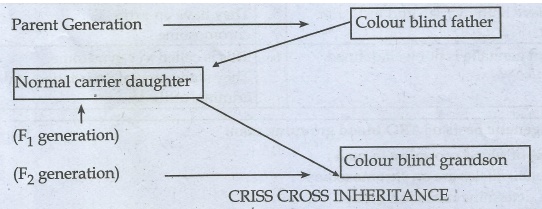
29. Why are sex linked recessive characters more common in the male human beings?
• Males are hemizygous.
• Therefore they express
the trait when they inherit one mutant allele.
• So, sex linked traits
are more common in males than females.
30. What are holandric genes?
• Genes in the
differential region of 'Y' chromosome are called Y. linked or holandric genes.
• The Y linked genes
have no corresponding allele in X chromosome.
• The Y linked genes
inherit along with Y chromosome.
• These genes
phenotypically express only in the male sex.
31. Mention the symptoms of Phenylketonuria.
• Mental Retardation
• Light pigmentation of
skin and hair
• Phenylpyruvic acid is
excreted in urine.
32. Mention the symptoms of Downs syndrome.
• Mental Retardation
• Increased separation
between eyes.
• Malformed ears.
• Tongue Protrudes
• Defective development
of Central Nervous system.
• Flattened nose.
• Mouth is constantly
open.
33. Differentiate Intersexes from Supersexes.
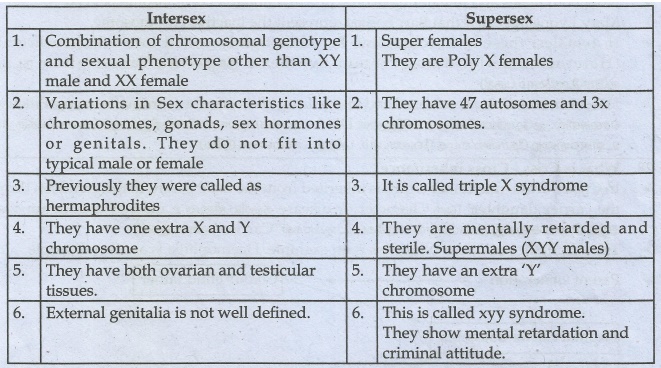
Intersex
1. Combination of
chromosomal genotype and sexual phenotype other than XY male and XX female
2. Variations in Sex
characteristics like chromosomes, gonads, sex hormones or genitals. They do not
fit into typical male or female
3. Previously they
were called as hermaphrodites
4. They have one extra
X and Y chromosome
5. They have both
ovarian and testicular tissues.
6. External genitalia
is not well defined.
Supersex
1. Super females
They are Poly X
females
2. They have 47
autosomes and 3x chromosomes.
3. It is called triple
X syndrome
4. They are mentally
retarded and sterile. Supermales (XYY males)
5. They have an
extra'Y' chromosome
6. This is called xyy
syndrome.
They show mental
retardation and criminal attitude.
34. Explain the genetic basis of ABO blood grouping man.
Genetic basis of blood grouping in man :
• Three autosomal
alleles are on chromosome 9.
• These alleles
determine the blood group.
• The gene for blood
group is labeled as 'L' (L - Landsteiner, the discover) or ‘I’
(I - Isoagglutinogen,
another word for antigen)
• I gene has 3 allelic
forms IA, IB, 1°
• IA
specifies A antigen
• IB for B antigen
• I° allele specifies no
antigen.
• Each allele produces a
transferase enzyme (These enzyme catalyse the transfer of sugar from one
molecule to another)
• IA allele
produces N - acetyl galactose transferase. It can add N - acetyl galactosamine.
• IB allele
produces the enzyme galactose transferase. This adds galactose to the precursor
(H substance)
• I° allele produce no
enzyme. So it is called 'null' allele. It cannot add NAG (N-acetyl glucosamine)
or galactose to the precursor.
35. How is sex determined in human beings?
Sex determination in human beings :
• Gene determining sex
in human beings are located in sex chromosomes (allosomes)
• Sex determination is
based on chromosomal differences between male and female.
• Females have XX
chromosomes. Males have XY chromosomes.
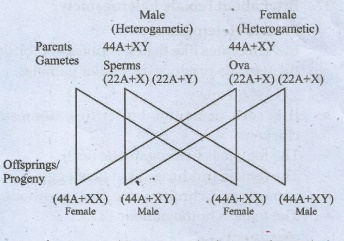
• Females are
homogametic. They produce only one type gamete (Each egg has one X chromosome)
• Males are
heterogametic. They produce 2 types of sperms. (One type with X and another
type with Y chromosome)
• This XY system or sex
determination is also seen in Drosophila.
• The sex of the embryo
depends on the fertilising sperm.
• The egg fertilised by
X sperm produce female.
• The egg fertilised by
Y sperm produce male.
36. Explain male heterogamety.
Male heterogamety :
• In this method of sex
determination, males are heterogametic. They produce dissimilar gametes.
XX-XO Type :
• It is in bugs,
insects, cockroaches, grasshoppers.
• The males are
heterogametic. They have only one X chromosome (XO)
• They produce 2 types
of sperms. One with X chromosome. The other half without X chromosomes.
• The sex of the off
spring depends on the sperm which fertilises the ovum (X sperm or O sperm)
XX - XY Type (Lygaeus type) (Ex. Man and Drosophila) :
• Here the males are
heterogametic.
• They produce 2 types
of sperms. Some with X chromosome. Some with Y chromosome.
• The sex of the embryo
depends on the fertilising sperm.
• The egg fertilised by
X sperm produce female.
• The egg fertilised by
Y sperm produce male.

37. Brief about female heterogamety.
Female Heterogamety :
In vertebrates like
fishes, reptiles and birds, the females produce dissimilar gametes.
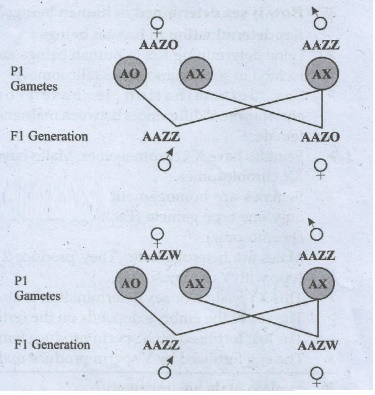
ZO - ZZ Type :
• It is seen in moths,
butterflies, domestic chickens.
• The female is
heterogametic (ZO)
• The female produces 2
kinds of eggs
• Some with Z
chromosome. Some without Z chromosome.
• The male is
homogametic (ZZ).
ZW-ZZ Type :
• It is in gypsy moth
(insects) and vertebrates like fishes, reptiles and birds.
• The female produces 2
kinds of eggs.
• Some with Z
chromosomes. Some with W chromosome. The male is homogametic (ZZ).
38. Give an account of genetic control of Rh factor.
• 3 different pairs of
alleles are located in 3 different close loci on the homologous chromosomal
pair -1 (Cc, Dd, Ee)
• This system uses Cde'
nomenclature
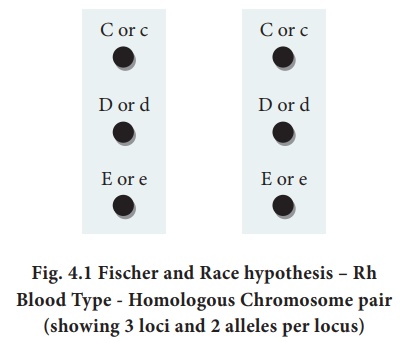
• The possible genotypes
are
One C or c
One D or d
One E or e
• For example
CDE / cde
CdE / cDe
cde / cde
CDe / CdE
• All genotypes with
dominant D produce Rh+ Phenotype
• Double recessive
genotype 'dd' produce Rh- phenotype
Wiener Hypothesis:
• Eight alleles (R1,
R2, R°, Rz, r, r1, r11, ry)
are at a single Rh locus.
• Genotype with dominant
'R allele' (R1, R2, R°, Rz) produce Rh+
positive phenotype.
• Double recessive
genotypes (rr, rr1, rr11, rry) produce Rh-
negative phenotype.
39. Explain the mode of sex determination in honeybees.
Haplodiploidy (Ex. Honey bee, wasp, Ants)
• The sex of the off
spring is determind by the numbers of sets of chromosomes
• Fertilized egg
develops into females. (Queen / worker honeybee)
• Unfertilised eggs
develop into males (or) drones. This is called parthenogenesis.
• So males have half the
number of chromosomes (haploid).
• Females have double
the number (diploid)
This system of sex
determination is called haplodiploidy. It is seen in hymenopterans.
40. Discuss the genic balance mechanism of sex determination with reference to Drosophila.
Genic Balance
Mechanism :
• It was first described
by C.B. Bridges in 1921.
• The sex of the
individual depends on the ratio of X chromosomes to the autosomes.
• Each X chromosome
carries female determining factors. Their value in 1.5.
• Autosomes carry male
determining factors. Their value is 1.0.
• Normale male is AAXY.
So, the male, female determinants are in the ratio of 2:1.5 (A = Haploid set of
autosomes). Here the genic balance favours maleness.
• Normal female has
male, female determinants in the ratio of 2:3 (AAXX = 2:3) Here the genic
balance favours femaleness.
41. What are the applications of Karyotyping?
• Gender identification
• To defect chromosomal
aberrations like
• Debetion • Duplication • Translocation • Nondisjunction
• To identify
chromosomal abnormalities (Ex. Aneuplidy)
• To predict
evolutionary relationship between species.
• Genetic diseases can
be detected.
42. Explain the inheritance of sex linked characters in human being.
Sex linked characters
in human being:
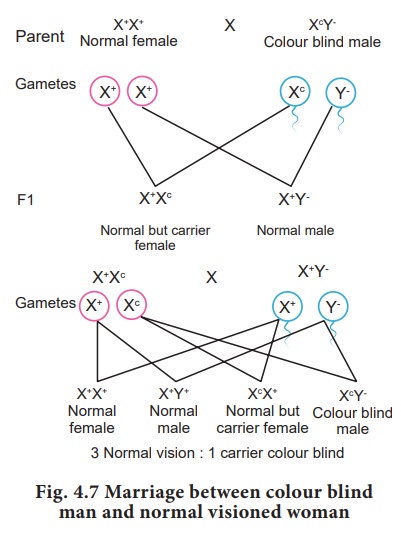
• Inheritance of traits
by genes located in sex chromosomes. It is called sex linked Inheritance.
• Genes in the
differential region of X chromosome are called X linked genes.
• Genes in the differential
region of Y chromosome are called Y linked genes (or) Holandric genes.
Inheritance of X -
linked genes:
Examples for X -
linked inheritance are
• Red - green colour
blindness or daltonism.
• Haemophila
• Duchenne's muscular
dystrophy.
• Let's see one example
in detail.
1. Haemophila:
It is caused by X -
linked gene.
• Persons with recessive
gene for haemophilia lack clotting substance (thromboplastin) in blood.
• Minor injuries lead to
continous bleeding and death.
• Females are carriers
of this disease. They transmit the disease to 50% of their sons.
• Haemophilia follows
criss cross inheritance (Father → daugher → grandson)
2. Colour blindness :
• A dominant X - linked
genes is needed for the formation of colour sensitive cones.
• Recessive form of
these genes are incapable of producing cone cells.
• So, homozygous
recessive females (Xc, Xc) and hemizygous recessive males
(Xc Y) are colour blind. They cannot distinguish red and green
colour.
43. What is extra chromosomal inheritance? Explain with an example.
Extra chromosomal
inheritance:
• Normally genes are in
chromosomes of the nucleus.
• Genes may be in
cytoplasm also. In cytoplasm these genes are in mitochontria (or) chloroplast.
• So, the pattern of
inheritance by extra nuclear genes is different from the genes of nuclear
chromosomes. This is called extra chromosomal inheritance.
• This extra chromosomal
inheritance is of Non - Mendelian pattern of inheritance.
• Only females transmit
cytoplasmic characters, because the ovum or egg contributes most of the
cytoplasm to the zygote. So this is called maternal inheritance or uniparental
inheritance.
• Example: Plastid
inheritance in 4'o' clock plant.
44. Comment on the methods of Eugenics.
Methods of Eugenics:
• Eugenics (Greek : Well
bom) aims at improving the genetic quality of human population. This is done by
excluding less desirable genetic groups and promoting superior genetic groups.
Negative Eugenics of
Methods:
• Sexual abstinence of
genetically less desirable.
• Sex education
• Use of contraception.
• Voluntary
sterilization, abortion.
• Incentives for
volunttary co - operation.
Positive Methods of
Eugenics :
• Financial incentives
to have children.
• Eugenic immigration.
New Methods of
Eugencis:
• Artificial
insemination by donor.
• Egg donation.
• Gene therapy.
• Cloning.
• Genetic engineering.
Related Topics